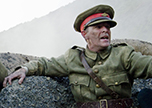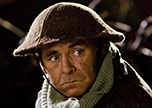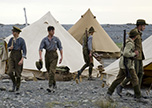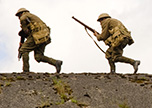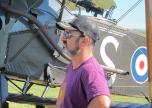« War News
Fact vs Fiction
Description
THE WAR NEWS EPISODES: WHAT'S REAL AND WHAT'S NOT?
War News is dramatised non-fiction. The series does not invent history or facts. It does use some fictional characters to give life to factual information, and obviously at the time there were no satellite links, TVs, video logs, smartphones or other such modern technology. While the use of this technology is implied, it is never actually seen.
The War News reporting team – Ray Harkness, Robyn Michaels, Jack Crawford, Paul Jameson and Joe Stevens – is fictional. New Zealand did have an official war correspondent, Malcolm Ross, a fairly conservative character who did spend time close to battlefields. One of the more controversial war correspondents was the Brit, Ellis Ashmead-Bartlett, who took the only known film footage of the August Offensive on Gallipoli. However, our fictional correspondents are not directly based on real-life correspondents, partly because censorship and nationalism played a significant role in war reporting during 1914-1918.
War News draws from a wide range of sources to ensure authenticity, including history books, contemporary newspaper reports and articles, diaries, letters, official despatches, TV documentaries, online articles and official military histories. We also worked closely with Ministry of Culture and Heritage historian Dr. Damien Fenton.
Some soldiers are fictional but they represent archetypes whose opinions and feelings are based on those expressed by real soldiers. Others are used to convey factual information (as best we know it). Some of the photos in the programme were taken by real soldiers - WWI was one of the earliest wars in which soldiers used personal cameras.
Generals and the battles they commanded are all real. Black and white photos and footage are all real (with two exceptions in the Gallipoli episode), but not every opportunity to show a real photo is used. For example, Generals Haig and Plumer are only shown as the actors who play them, to avoid confusion.

Left: Tim Gordon as General Sir Douglas Haig, Right: General Sir Douglas Haig
Names of commands, formations, units and ranks are all real.
Information in the Robyn Michaels history and strategy segments is historically accurate. She represents, albeit to a radical degree, the very start of New Zealand women working in white-collar professions during the war.
Fictional political pundits Costello and Johnson appear in several episodes. Broadly speaking, they represent wartime conservative and liberal New Zealand. It's important to note that, at the time, the Great War was not critiqued in the way a modern audience would expect: field reports were censored, and few New Zealanders questioned the rationale or need for the war overall. So our commentators' views are loosely based on a range of sources, mainly historical accounts and newspaper reports.
Texts we used include:
- Devils On Horses, by Terry Kinloch
- Gallipoli: The New Zealand Story, by Christopher Pugsley
- The Great Wrong War, by Stevan Eldred-Grigg
- Haig’s Generals, edited by Ian F.W. Beckett & Steven J. Corvi
- The Great War, by Les Carlyon
- Gallipoli: The End of the Myth, by Robin Prior
- Great Battles of World War I, by Anthony Livesey
- The Illustrated History of World War One, by Ian Westwell
- The Western Front 1914-1916, by Michael S. Neiberg
- The Western Front 1917-1918, by Andrew Wiest
- New Zealanders at War, edited by Gavin McLean & Ian McGibbon with Kynan Gentry.
- The Devil’s Own War: The Dairy of Herbert Hart, edited by John Crawford
- Armstrong University Journal of History
While War News does its best, not all facts are universally agreed, and the production budget is modest (by international standards). For any imprecise creative license taken, and for any other inaccuracies including insignia and relocation of footage, we apologise. Please enjoy.
EPISODE 1: THE GALLIPOLI EVACUATION, 1915
The Gallipoli Campaign was launched with the Anzac landings on April 25th, 1915. It was meant to be a quick Allied victory but the Ottomans proved to be a far stronger enemy than anticipated. After eight months of fighting the Allies decided to withdraw from the peninsula. The evacuation of the Anzacs took place in late December 1915. Over several nights more than 40,000 troops slipped away under cover of darkness within range of Ottoman observation posts and artillery batteries. But the enemy seemed unaware and the Anzacs suffered no casualties. Most historians agree it was the most successful Allied operation in an otherwise disastrous campaign.
War correspondents Crawford and Jameson are on Gallipoli to cover the last night of the Anzac evacuation on December 20th, 1915. Around 10,000 Anzac troops are still to leave. Among them is Kiwi soldier Trooper George Allison, whose parents await his safe arrival at Anzac Cove from the front line trenches. George and his parents are fictional but their story reflects what many Kiwi soldiers and their families experienced during 1915: the initial euphoria felt when war was declared eventually faded and was replaced with dread, grief and the brutal reality of war.
The Kiwi soldiers interviewed about the evacuation are fictional but the feelings they express about leaving – some were glad to go, others felt the fight wasn’t over – are based on diaries and letters of soldiers on Gallipoli. George Allison’s view that the campaign was a "waste" and the shame he feels about leaving, are also based on personal accounts.
On the day of the landings, with the Anzacs under pressure from the Ottomans, some Anzac commanders called for a withdrawal. In the early hours of April 26th, 1915, British commander General Hamilton discussed the request at a meeting with senior officers and concluded the Anzacs must “dig in”. We’ve shown the meeting in a “leaked recording” but the characters are based real people, such a meeting did take place, and the substance of the discussion is based on historical accounts of the meeting. Some black and white footage of the landing itself is actually a reenactment, probably dramatised in Sydney in 1918.
Lt.-Col. William Malone, commander of the Wellington Battalion, lost his life on Chunuk Bair. His video diary entry is based on two heartfelt letters he wrote to his wife on August 5th, 1915, just three days before he was killed in battle.

Left: Peter Hambleton as William Massey, Right: A portrait of William Massey
Comments by New Zealand wartime Prime Minister William Massey about the strategic reasons for the evacuation are based on historical accounts and newspaper reports. His views about New Zealand’s role in the British Empire and why Germany must be defeated reflect commonly held views in New Zealand at the time.
General Godley was Anzac commander at the time of the evacuation. His moving farewell statement is based on a letter he wrote to the Ottoman GOC (General Officer Commanding) on the Ari Burnu Front, and on a December 1915 newspaper report.
Military expert Roger Hunt is fictional but his assessment of the evacuation is based on historical accounts. Journalist Henry Paulson is also fictional. His controversial account of atrocities within the Ottoman Empire is based on historical accounts, though some of these accounts are still contentious.
The evacuation was completed under a full moon and on a very still night. Troops would likely have extinguished all lights and taken only the lightest personal gear with them, so a few liberties were taken during filming for effect. But details such as the diversionary rifles, hessian-covered boots and the explosion of an Ottoman artillery shell in Anzac Cove during the evacuation are real events as described in letters by Anzac soldiers and newspaper reports. Believed to be routine shelling, the shell landed short and there were no casualties.
EPISODE 2: THE SOMME OFFENSIVE, 1916
The Battle of Flers-Courcelette in September 1916 saw two significant debuts. It was the first time tanks were used in battle and the New Zealand Division’s first major battle on the Western Front. Flers-Courcelette was one of the many battles of the Somme Offensive, a costly struggle that resulted in more than one million German and Allied casualties in just five months. Eight thousand of the casualties were Kiwis.
During the war, 28 Kiwi soldiers were court-martialled and sentenced to death. Five were executed: one for mutiny, four for desertion. The other 23 had their sentences commuted or quashed on review. Crawford reports on the court-martial of Kiwi soldier Corporal Bill Butler, who stands accused of cowardice and faces execution by firing squad. He is in fact suffering from shell shock, a newly-recognised and poorly understood condition at the time. Corporal Butler and his court martial are fictional and are designed to show, a) the court martial process and the fact that Kiwi soldiers were tried by fellow Kiwis, b) the unforgiving military attitude towards disobedient or defiant soldiers, and c) the general ignorance of military and medical authorities surrounding shell shock, a term first published in 1915 in British medical journal, The Lancet.
Crawford’s comments about details of the court-martial – the basis for the charge, the court procedure, the likely sentence and so on – are based on historical accounts. Butler’s lawyer, Major Trent is fictional but some court-martialled men did have legal representation. However, we’ve taken dramatic license with Trent’s more liberal views (at the time) on shell shock and the military’s treatment of Corporal Butler.
We’ve used a “covert recording” to show the moment Corporal Butler failed to follow orders and go into battle. This fictional account is designed to show the aggressive reaction Butler’s sergeant would have had to a soldier refusing to go over the top.
Like all generals in War News, General (later Field Marshal) Sir Douglas Haig is a real person. His somewhat terse interview with Harkness is based on Haig’s own despatches, a letter to his wife, and historical accounts of the still controversial British commander.
Harkness’s interview about anti-German sentiment in New Zealand deals with a real and significant issue in the country at the time. Of the three participants, only Paul Hansen is real – he was Danish vice-consul and was actually interned on Somes Island. Jenny Mason is fictional but the organisation she represents – the Anti-German Women’s League – is real and her views are based on those expressed by members of the League in newspapers and other publications. Lutheran minister Jurgen Braun is also fictional but his description of the treatment of Lutherans, including the torching of a Lutheran Church, is based on newspaper reports.
Artillery officer Lt. Bruce Rogers is a good example of how a fictional character can be used to bring historical fact to life in an engaging way – in this case the devastating impact of artillery. In Jameson’s report on the tank, Captain Lance Hall, also a fictional character, is used for the same purpose.
Māori leaders Te Puea Herangi and Maui Pomare are important historical figures who had opposing views on the war, including Māori conscription. Their fiery encounter in the studio over the issue is fictional, but what Te Puea and Pomare say is based on newspaper reports and on statements they made at the time.
EPISODE 3: PASSCHENDAELE, 1917
On October 12th, 1917 the New Zealand Division was among the tens of thousands of Allied troops involved in a disastrous attempt to capture ground around the Belgian town of Passchendaele. The assault was part of the 3rd Battle of Ypres, better known as the Battle of Passchendaele. Heavy rain, deep mud, lack of artillery support and strong German counter-attacks met infantrymen already exhausted from the Battle of Poelcappelle three days earlier. Among that day’s 13,000 Allied casualties, more than 2000 were Kiwis, with 846 dead. It is the blackest day in New Zealand’s military history.
Crawford is at the front line with the Kiwi troops as they prepare to attack. Details of the extreme conditions and seemingly futile task faced by the New Zealanders that morning are drawn from historical accounts, personal accounts of soldiers and from accounts of the attack by Australian war correspondent, Charles Bean.
Major William Turner was a company commander in the 2nd Otago Battalion, the first Kiwi battalion to go over the top at zero hour that morning. Turner is mentioned in the Otago Regiment’s official history and in newspapers. His view that the battle should have been postponed because of extremely adverse conditions including bad weather, exhausting mud and lack of artillery support is based on historical accounts and the N.Z.E.F.’s official history. Turner was killed in the battle.
Jameson’s “behind the scenes” report from GHQ and the content of his interviews with generals involved in the decision to attack on October 12th is based on several sources: historical accounts, the official history of the Australian Imperial Force (AIF), newspaper reports that speculated on the reasons why Haig decided to attack, and on Haig’s own despatches. Details of specific times when certain decisions were made in the days and hours leading up to zero hour on October 12th are taken from the AIF’s official history.

Left: Gerald Bryan as Sir James Allen, Right: Sir James Allen
Sir James Allen was New Zealand’s wartime Minister of Defence. In his interview on conscientious objectors and anti-conscriptionists, Allen’s statements and opinions are based on a report that he commissioned from the Joint Defence Legislation Committee, which met in late 1913 (almost a year before the war started in August 1914) to discuss conscientious objectors, alternative service and military camps.
Sgt. Wi Kingi is fictional. He represents the men of the (mainly Māori) Pioneer Battalion who helped other Kiwi and British tunnellers to create the remarkable Arras tunnel network.
Kiwi pilot Captain Keith Park of the Royal Flying Corps was among the most successful British fighter pilots in WWI. He and his gunner Arthur Noss received the Military Cross for shooting down four German planes within 30 minutes one morning in August 1917. Park’s description of the half-hour long dogfight is based on historical accounts. Park was later an RAF commander in the Battle of Britain during World War Two.
EPISODE 4: THE SINAI-PALESTINE CAMPAIGN, 1916-1918
After Gallipoli, the men of the New Zealand Mounted Rifles Brigade (NZMR) were reunited with their horses in Egypt. As part of the Egyptian Expeditionary Force they fought in a long campaign that first pushed Ottoman forces from the Sinai Peninsula and then destroyed the Ottoman armies in Palestine. However, the triumphant campaign was overshadowed by tragic events at the village of Surafend in late 1918. The murder of a Kiwi soldier provoked Anzac soldiers to set fire to the village and massacre dozens of Arab men.
Kiwi soldier Trooper Leslie Lowry was killed in the early hours of December 10th, 1918, six weeks after war with the Ottomans had ended – no photo of the real Lowry is known to us. The suspect was an Arab man who allegedly fled to Surafend. Lowry’s comrade Corporal C.H. Carr is reported to have been first on the scene and the investigating officer really was a British Army Major by the name of Magnus Johnson. Events surrounding Lowry’s murder and the massacre in Surafend are based on historical accounts. Johnson’s speculation on the identity of the murder suspect is based on evidence found at the crime scene.
Carr’s controversial comments about the alleged killer are based on personal accounts of Anzac soldiers who felt aggrieved by the apparent leniency shown by British officers towards local tribespeople who allegedly committed crimes against the Anzacs.
The Sinai-Palestine Campaign could not have been won without horses. The report by Joe Stevens on the thousands of Kiwi horses shipped to Egypt for the war is based on historical facts and on the official histories of both the New Zealand Mounted Rifles and the Australian 7th Light Horse Regiment.
New Zealand was not immune to the influenza pandemic that swept the world and killed millions in late 1918. Prime Minister William Massey’s comments about the crisis, including his government’s response and his own possible culpability in the matter (via the passenger ship Niagara) recall historical incidents.
When conscription was applied to Māori in 1917 it did cause a rift between pro- and anti-war Māori. Māori leaders Te Puea Herangi and Maui Pomare were at the forefront of the debate and divided on the issue. The heated debate in which they argue the costs and benefits of Māori conscription is based on historical accounts, newspaper reports and biographies of Te Puea and Pomare.
We first met Trooper George Allison during the Gallipoli Evacuation (episode 1). He’s fictional but represents the Kiwi mounted riflemen who returned to Egypt after Gallipoli and pursued the style of warfare for which they were trained: on horseback. His video diary entries are based on historical accounts, personal diaries and the NZMR’s official history.
Kiwi safe-sex campaigner Ettie Rout was a controversial figure during the war. In the House of Lords she was described as the “wickedest woman in Britain” while elsewhere she was dubbed the “guardian angel of the Anzacs”. Her comments about the sexual health of the troops are drawn from biographies of Rout, newspaper reports and from Rout’s own writings.
EPISODE 5: LE QUESNOY, 1918
The liberation of Le Quesnoy by the New Zealand Rifle Brigade (NZRB) in early November 1918 was one of the war’s great acts of courage. Not wanting to destroy the historic town or harm civilians with artillery fire, the Kiwis instead stormed the town walls using a single ladder and defeated the German garrison. Streets and landmarks in the town were subsequently named in honour of New Zealand and to this day Kiwis are welcomed with warmth and affection by the people of Le Quesnoy.
Major Harold Barrowclough was the 24-year-old commander of the NZRB’s 4th Battalion. It was on his order that Kiwi troops went over the wall. His descriptions of his battalion’s actions that day are based on the NZRB’s official history. Names of soldiers, times of events and the actions of the three other NZRB battalions involved in liberating Le Quesnoy are taken from the Brigade’s official history and from personal accounts by 2nd Lt. Leslie Averill (who was first up the ladder) and other Kiwi soldiers. The wall scaled by the 4th Battalion was, in reality, made of brick not concrete as shown in the episode.
In 1918, the German military unleashed a massive supergun that could fire a shell 75 miles. In the course of the shell’s trajectory it reached the stratosphere and gunners had to account for the Earth’s rotation in determining their target. Military expert Roger Hunt is fictional but his description of the Paris Gun is based on historical accounts and a 1930 article in Modern Mechanix.
Life was harsh for French civilians in German occupied towns. Every aspect of daily life was controlled or limited. Like many towns in northern France, Le Quesnoy was occupied for four long years. The anonymous French woman who describes life under German rule is fictional, but her “testimony” in the smuggled recording is based on historical accounts. The repeated surrender demands made by the Kiwis to the German commandant in Le Quesnoy are based on real events.
Prime Minister William Massey’s view that Kaiser Wilhelm should be tried for war crimes is based on actual comments Massey made in 1919 as a member of the War Crimes Commission.
Outlawing alcohol (Prohibition) was a hotly debated topic during the war and public opinion was almost evenly divided on the matter. The views expressed by Massey are based on a letter to the public written in 1919 by Sir James Allen (Acting PM at the time) that was published in newspapers around the country.
New Zealand’s military took dental hygiene seriously and the New Zealand Dental Corps was the first such corps in the British and Dominion armies. Captain Francis Finn is fictional but his comments are based on the official history of the New Zealand Dental Corps.
1918 saw the case of Hugh Goldsbury, a Wanganui teacher who refused to salute the flag. He was sacked over the matter but later reinstated after a compromise was reached. The content of his interview is based on a School Committee letter, a letter from Goldsbury to the Wanganui Education Board and comments made to the Board by Goldsbury’s mother.



